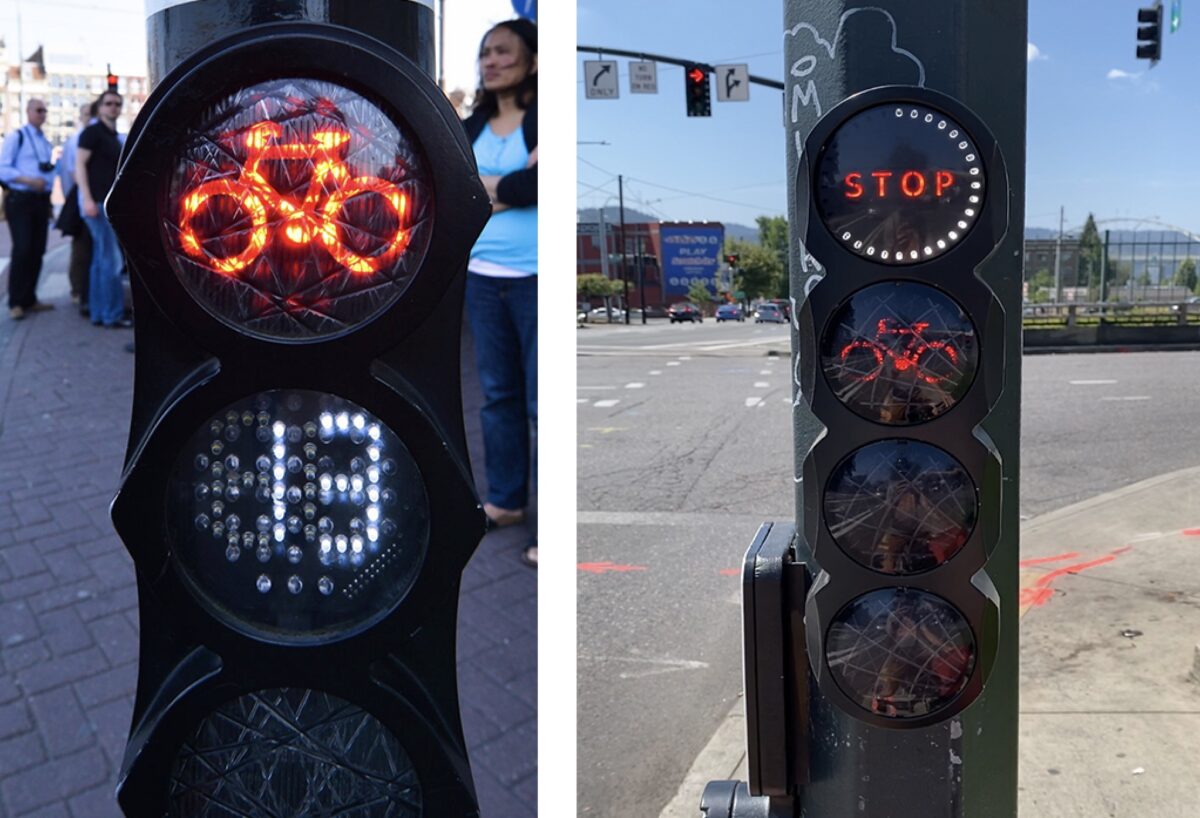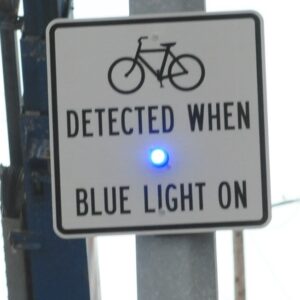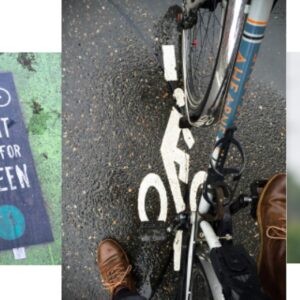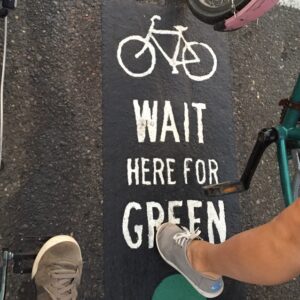
(Photos: Jonathan Maus/BikePortland)
The infamous Broadway and Williams intersection has a new signal. I say infamous because this location has a long and sordid history of right-hooks and interventions by the City of Portland to try and stop them. The latest change is aimed at helping bicycle users comply with the traffic signals.
The Portland Bureau of Transportation has installed a new “near side” (meaning it’s close to where you wait) signal with a sensor that triggers a countdown timer. The signal is part of a statewide research project to figure out what type of bike signals will work best. In a Tweet last week, PBOT said this new signal is the first first “Dutch-style countdown signal in the United States” (but it appears to be similar in function and provenance to the bike signal at N Interstate and Oregon).
Portlander Gerben Gerritsen is happy to see the new signal. He remembers them fondly from his hometown of Utrecht, a city in the Netherlands and one of the most bike-friendly places in the world. “It’s a life changer. I’m glad they’re coming to Portland,” he shared with us. “You know how long you’ll have to wait. That way you know if you have time to take off your gloves, check your backpack, phone etc. No mid-process scramble when you’re taking off your jacket.”
Advertisement
The new signal, which came to Portland directly from the Netherlands, is triggered by a sensor in the bike lane about 30 feet before the intersection. When you roll over it, the bright lights on the countdown circle go on immediately. This feedback is key. According to researchers behind the project, these “bicycle feedback confirmation devices” are meant to, “better communicate presence detection and delay to people on bicycles.” The thinking is when bicycle users know a signal is aware of their presence, they’re more likely to wait and comply with it. Another feedback device being used in Portland is a bright blue light that turns on when you approach an intersection.
This research is important because bicycle signals do not currently have full federal approval. Since 2013 the Federal Highway Administration has only granted bicycle signals “interim approval” status which limits their implementation. PBOT engineers hope data they collect can inform research that persuades the FHWA to grant full approval.
The detection system with this signal is more advanced than others because it doesn’t require you to place your bike in a specific spot while waiting. Educating bicycle riders on how to trigger green lights has been a challenge for PBOT. A 2013 study revealed that about half of riders have no idea how to do it.
Portland currently has about 30 bike-only signals citywide. The first one was installed in 2004 at Interstate and NE Oregon near Peace Park.
— Jonathan Maus: (503) 706-8804, @jonathan_maus on Twitter and jonathan@bikeportland.org
— Get our headlines delivered to your inbox.
— Support this independent community media outlet with a one-time contribution or monthly subscription.






Thanks for reading.
BikePortland has served this community with independent community journalism since 2005. We rely on subscriptions from readers like you to survive. Your financial support is vital in keeping this valuable resource alive and well.
Please subscribe today to strengthen and expand our work.
How long will you have to wait? Is each of those LEDs a 1 second count? It seems more that we don’t know how long we have to wait but at least there’s something counting down until you get to go.
This will also cause some riders to go against the signal because they know they have to wait longer than they want to.
They really need to have a countdown number, like the useless crosswalk countdown timers.
The graphic approach is taken because the actual time until green varies greatly at actuated signals. A countdown if installed would regularly reduce from numbers greater than 1 to 0.
The research is specifically looking at the change in signal compliance after installation so there should be data reported back soon on whether or not riders arriving to a long countdown are disregarding the signal.
It doesn’t literally tell you how long, but it’s still a huge help to have some sense of how long it will be in rough percentage terms, as opposed to just sitting there waiting and wondering and getting frustrated.
Countdown timers are only possible with fixed-time signals like we have downtown. Any signal that is actuated with loop detectors has variable times depending on demand, so there’s no way to generate a countdown with a specific number of seconds. These dots are showing a dynamic percentage of remaining cycle length.
Why does variable timing mean the signal can’t show how many seconds remain? Shortly after detection, the signal system must have the bicycle’s right of way scheduled into a known position in the queue, right? Why can’t it just sum up time for the slots above the bicycle in the queue then report that time back to the bicycle signal for the count-down?
If there is no traffic I’m going to go. Traffic is only a problem for a portion of the day
We’ve had one of these for years at the diagonal crossing in the Rose Quarter, though it’s sometimes hard to see across the intersection. That one is an actual signal from the Netherlands which originally said “WACHT” (meaning wait) but with some handy black tape to cover up the C and part of the H, it now says WAIT. Because of the variability in cycle length there, the countdown dots sometimes count down in big chunks, so it’s not the ideal location for it. Hopefully this new American take on the Dutch signal at Broadway & Williams will be more consistent of a countdown. It does seem like the cycle length is more predictable there.
I personally love this style of signal. It really helps psychologically to have some sense of how long you might have to wait at a traffic signal.
Thank you, Peter Koonce.
Hey Jonathan, very cool pics! But how about some video of it in action? Trigger it and then let it step through its process so we can see see the full show! Thanks.
I posted video on my Instagram story yesterday. Will upload and share here ASAP.
Thanks for the video Jonathan. The lights disappearing “at a certain rate” does give a user a good understanding of the anticipated delay. Thanks for adjusting the camera to see the bottom light activated to indicate “proceed”. Curious (again), assuming the light above is a yellow one…. does it also indicate with some sort timing counter as to how long the light will remain yellow? Or is there a green and yellow light waiting across the way for the cyclist to see/know how long they have to cross before it is red?
Thanks Portland (PBoT) for pushing ahead on these incremental innovations. I remember fondly our 2006 city study tour to the Netherlands (with Mayor Adams and BTA) to investigates these very common safety tools for bikes.
But I am so ‘pissed’ that the FHA / FHWA is taking decades to move forward on these well used and documented (outside of US) tools and treatments. Sadly if it is an international best practice developed elsewhere then its is as if it cannot be easily transferred to the US. It seems FHA/ FHWA will move heaven and earth for new autonomous vehicle tools / practices and anything for motorized vehicles but ped and bike treatments have to ‘go slow’.
Couldn’t agree more, the blue bike detector indication lights on the west head of the Sellwood Bridge, ODOT owned, still aren’t on because they’re not FHWA approved.
The cyclists at this intersection aren’t the problem! The No Turn on Red sign should be much larger and illuminated. I’ve had to yell at a number of cars from not turning on red. The turn lane closest to the bike lane is the worse! Not sure if larger or brighter signs will do the trick but it would help.
There’s a second, electronic No Turn On Red sign that turns on when the bike signal is green at this intersection.
This is still a stressful intersection, though. I’m always really wary when using it on a bicycle; I keep a close eye on the front car in the right turn lane to make sure they’re not making any movements or looking like they’re trying to turn on red.
I’ve found that motorists are more interested in looking left (for an opening) than looking at signs.
I’d like to see more photos of what the other two lights on the signal look like.
Added a video Patrick. https://youtu.be/BRJOdwEl1Jw
Remove a lane of traffic for a protected bike lane on Broadway/Weidler so we can use this.
Yawn; I know the Dutchophiles will salivate over this, but we need so much more than this, and the new path on Greeley doesn’t really cut it either from what I’ve read.
And
Got me feeling like they don’t understand the real problem.
Better bike signals don’t solve right hooks. Completely unrelated.
Also,
It doesn’t help that when I follow “the directions” and bisect the sensor circle with my steel bike, the sensors don’t react differently at different intersections. :\
Of course, at the end of the day, it’s nice to have bicycle infrastructure built out. Even if it is “flavor of the month” and remains unique across the whole city. Young cities have to experiment.
Wha??? Bike signals are literally designed to solve right hooks by separating movements in time. How can you say they’re completely unrelated?
I guess what I’m saying is, from my perspective, the behavior is independent of traffic controls. Right hooks aren’t exclusive to intersections controlled by traffic signals. They also occur mid-block at parking lot entrances. They happen at side street turn offs, where the car has no traffic controls other than the standard yields in place (pedestrians and bike in bike lane). They also occur at those nasty freeway on ramps like the one at Capitol and Barbur, where cars race to get ahead of the bike to get one lane over.
The elephant in the room is the slow turn of death right hook; the motorist is looking left to merge right and creeps into the intersection, such as SW Harbor Dr onto SW Nato. I have a story about a coworker who had just taken up cycling. She was run over by at this intersection. She was exiting the park and crossing Nato, while the motorist was doing the slow right turn of death – looking left turning right. Her ankle was broken, now she has a debilitating injury.
There is a lot of places where traffic controls don’t protect cyclists from a right hook. So a new fancy light for cyclists to obey seems to put the onus onto cyclists.
I meant “react differently” but I’ve missed the editing window of opportunity. Not “don’t react differently”.
As I think about it, the one that I wait the longest for is at “Hwy 26 / Arthur St and SW 1st Ave”. I guess I can blame ODOT for that nonsense, I’m sure they tuned the sensors for cars and bigger conductors.
At this intersection, light traffic generally makes it easy for me to use the right hand through traffic lane (second lane from the left), bypassing the DEADLY right hook trap in the narrow, incorrectly located bike lane. Squeezing through that is just asking for trouble. The nifty new signal is lipstick on a pig, for those who seek a false sense of safety by adhering to the sidewalk riding mentality.